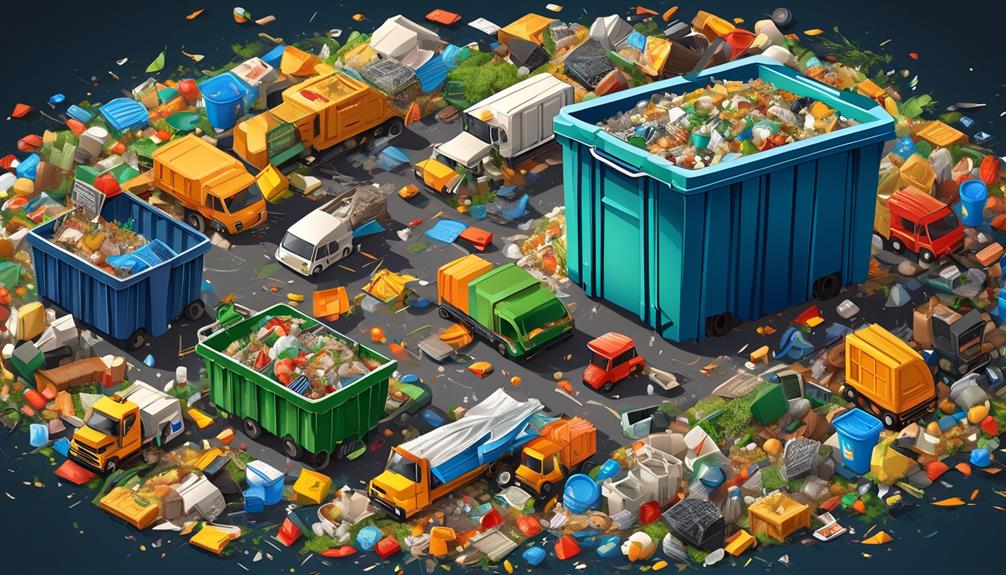As the saying goes, 'One person's trash is another person's treasure.' When it comes to understanding the impact of recycling, statistics play a crucial role in shedding light on the effectiveness of our waste management efforts.
The numbers reveal not only the volume of materials being recycled but also the areas where improvement is needed. From the surprising amount of paper and paperboard products being recycled to the sobering reality of plastic recycling rates, the data paints a comprehensive picture of our current recycling landscape.
But what do these statistics mean for our environment and future sustainability efforts?
Key Takeaways
- Recycling rates for municipal solid waste (MSW) reached 32.1% in 2018.
- Paper and paperboard products made up around 67% of the materials recycled.
- Yard trimmings composting increased from negligible levels in 1980 to 63% in 2018.
- Recycling, composting, and combustion with energy recovery saved over 193 million metric tons of carbon dioxide equivalent (MMTCO2E) in 2018.
Generation of Waste
The generation of waste has increased significantly since 1990, with a per capita increase from 4.5 to 4.9 pounds per person per day in 2018. This rise is concerning, especially considering the total municipal solid waste (MSW) generated in 2018 was a staggering 292.4 million tons.
It's alarming to see such a substantial increase from the 1960s when MSW generation was only 88.1 million tons. What's even more worrying is that the generation rate per person per day has almost doubled from 2.68 pounds in 1960 to 4.9 pounds in 2018.
Looking at the composition of this waste, it's interesting to note that while paper and paperboard products made up the largest percentage of MSW, the actual amount of these products declined from 87.7 million tons in 2000 to 67.4 million tons in 2018. On the other hand, plastic products generation saw a significant increase, reaching 35.7 million tons in 2018, which accounted for 12.2% of the total generation.
These statistics underscore the pressing need for effective waste management and recycling initiatives to curb the escalating generation of waste.
Municipal Solid Waste Management

I oversee waste collection methods, recycling infrastructure, and landfill reduction efforts in our municipality.
Our focus is on improving the efficiency of waste collection to ensure that recyclable materials are properly sorted and processed.
Additionally, we're working to expand our recycling infrastructure and promote composting to reduce the amount of waste sent to landfills.
Waste Collection Methods
In urban areas, curbside collection stands as the most common method for managing municipal solid waste. This method involves the pick-up of household waste at the curb or in alleys.
Drop-off centers provide a location for individuals to bring their waste for disposal or recycling. These centers are often used in rural areas with limited curbside collection.
Transfer stations serve as an intermediate collection point where waste is consolidated. After consolidation, the waste is then transported to landfills or recycling facilities.
Municipal solid waste management also includes various forms of recycling, composting, and combustion with energy recovery. These methods aim to reduce the amount of waste going to landfills.
These different methods, tailored to different areas, contribute to effective waste management and help keep our communities clean and sustainable.
Recycling Infrastructure
Utilizing modern recycling infrastructure is essential for effectively managing municipal solid waste and promoting sustainability in our communities.
The infrastructure includes facilities for sorting, processing, and recycling materials, as well as for disposing of non-recyclable waste in an environmentally responsible manner. These facilities play a crucial role in ensuring that recyclable materials are properly sorted and processed, reducing the amount of waste that ends up in landfills.
Additionally, modern recycling infrastructure supports the development of a circular economy by creating a system where materials can be reused and repurposed.
Landfill Reduction Efforts
Advancements in technology and processes are aiding in the reduction of municipal solid waste sent to landfills, promoting a circular economy for materials.
To achieve this, strategies such as increasing recycling and composting rates, promoting sustainable materials management, and implementing waste reduction initiatives are being employed.
Additionally, municipalities are adopting waste diversion programs to encourage residents and businesses to recycle, compost, and limit waste generation.
This collaborative effort among government, industries, and communities is essential to achieve significant landfill reduction and improve municipal solid waste management.
Recycling Trends

Experiencing a steady increase over the years, recycling rates for municipal solid waste (MSW) reached 32.1% in 2018. This upward trend indicates a positive shift towards more sustainable waste management practices.
Notably, paper and paperboard products made up around 67% of the recycled materials in 2018, with corrugated boxes, mixed nondurable paper products, and newspapers/mechanical papers being the most commonly recycled items.
Furthermore, the increasing trend in yard trimmings composting, which rose from negligible levels in 1980 to 63% in 2018, demonstrates a significant advancement in organic waste management.
The environmental impact of these recycling trends is substantial. In 2018, recycling, composting, combustion with energy recovery, and landfilling of MSW saved over 193 million metric tons of carbon dioxide equivalent (MMTCO2E). This amount is equivalent to removing almost 42 million cars from the road for a year, highlighting the positive effect of recycling on reducing greenhouse gas emissions.
However, challenges persist, particularly in plastic recycling. While global plastic recycling rates vary, only a small percentage of plastic waste is actually recycled into new products, emphasizing the need for increased investment in plastic recycling infrastructure to further improve recycling rates.
Composting and Food Management

I want to highlight the crucial role of composting in managing food waste.
With over 25 million tons of municipal solid waste (MSW) composted in 2018, it's evident that composting is an effective method for reducing organic waste.
The significant portion of yard trimmings and food waste composted demonstrates the potential for diverting organic waste from landfills and highlights the diverse approaches to food waste reduction.
Food Waste Reduction
The significant increase in food and yard trimmings composting between 2015 and 2018 reflects positive progress in reducing food waste. This indicates a growing awareness and concerted efforts to tackle the issue.
The statistics reveal several key points:
- In 2018, 25 million tons of Municipal Solid Waste (MSW) were composted, with yard trimmings accounting for a significant portion of the composted amount.
- Approximately 2.6 million tons of food waste were composted, while an additional 17.7 million tons of food waste were managed through other methods such as animal feed, co-digestion, and land application.
- Recycling and composting of MSW in 2018 accounted for almost 94 million tons, with an additional 17.7 million tons of other food management, showcasing the growing focus on food waste reduction.
These facts underscore the diverse approaches being employed for food waste reduction, highlighting the progress made and the potential for further advancements.
Composting Benefits
Amid the positive progress in reducing food waste and yard trimmings composting, the benefits of composting, particularly in food management, become evident through its role in reducing methane emissions and enhancing soil health. Composting organic waste not only reduces the volume of waste in landfills but also helps in mitigating the production of leachate and the contamination of soil and water. Additionally, it provides nutrient-rich soil, decreasing reliance on chemical fertilizers and pesticides while promoting plant growth. The table below summarizes the key benefits of composting in food management:
| Benefits | Description |
|---|---|
| Reducing methane emissions | Composting decreases the amount of food waste sent to landfills, thereby reducing methane emissions. |
| Enhancing soil health and plant growth | Composting produces nutrient-rich soil, promoting soil health and providing a sustainable alternative to chemicals. |
| Extending landfill lifespan | By reducing the overall volume of waste in landfills, composting helps extend the lifespan of these facilities. |
Greenhouse Gas Benefits

Contributing over 46 million tons to the overall savings, recycling paper and paperboard products resulted in the largest portion of the total greenhouse gas reduction in 2018. This underscores the significant impact of paper recycling on mitigating climate change.
The following key points further illustrate the greenhouse gas benefits of sustainable waste management practices:
- Recycling, composting, and other waste management methods collectively saved over 193 million metric tons of carbon dioxide equivalent in 2018, showcasing the substantial environmental impact of these practices.
- This reduction is akin to removing nearly 42 million cars from the road in a year, emphasizing the scale of the positive environmental influence of sustainable waste management.
- The EPA's Waste Reduction Model (WARM) serves as a crucial tool for estimating greenhouse gas reductions from sustainable materials management, facilitating a better understanding and promotion of the environmental benefits of recycling.
The comprehensive data and tools provided by the EPA, including ongoing advancements, are pivotal for comprehensively assessing the greenhouse gas benefits of sustainable waste management practices and further advocating for their adoption.
Material-Specific Recycling Facts

In 2018, paper and paperboard accounted for approximately 67% of the recycled materials, making them the most prevalent recycled products. Corrugated boxes, mixed nondurable paper products, and newspapers/mechanical papers were the most-recycled paper products in 2018. Metals comprised about 13% of the recycled materials, while glass, plastic, and wood made up between 4 and 5%. The overall recycling rate in 2018 was 32.1%.
| Material | Percentage of Recycled Amount |
|---|---|
| Paper and paperboard | 67% |
| Metals | 13% |
| Glass | 4-5% |
| Plastic | 4-5% |
| Wood | 4-5% |
These figures show the significant contribution of paper and paperboard to the recycling stream, indicating the importance of promoting recycling initiatives for these materials. Additionally, the relatively low recycling rates for glass, plastic, and wood highlight areas for potential improvement in recycling efforts. Understanding the specific breakdown of recycled materials can better inform strategies to increase overall recycling rates and reduce waste.
Recycling Challenges

The significant contribution of paper and paperboard to the recycling stream highlights the importance of addressing the various challenges faced in the recycling process. As I delve into the recycling challenges, it's imperative to understand the complexities that hinder the recycling ecosystem.
- Plastic recycling poses significant challenges due to its high cost and energy-intensive process, making it less economically viable than other materials.
- Misinformation contributes to low recycling rates, particularly in plastic recycling, as many individuals are uncertain about which plastics are recyclable.
- The U.S. faced a decline in plastic recycling due to import bans and outsourcing, resulting in a strain on domestic recycling infrastructure and capacities.
- While paper recycling has seen success with a 68% recycling rate in 2021, there are still challenges to address, particularly in the recycling of mixed paper and magazines.
- Public confusion about recycling is causing a crisis in the U.S., with recycling levels at 21.4%, highlighting the urgent need for improved education and communication about recycling practices.
Understanding and addressing these challenges will be crucial in enhancing recycling rates and creating a more sustainable future.
Frequently Asked Questions
What Are the Primary Reasons Why People Choose Not to Recycle?
I don't recycle because of lack of awareness about its benefits, inconvenience and limited access to recycling facilities, perceived time and effort, doubts about effectiveness, and unclear guidelines.
How Does Recycling Impact the Job Market and Employment Opportunities?
Recycling opens doors to job opportunities. It boosts the economy by creating roles in collection, processing, and manufacturing. Demand for recycled products drives employment in green technology. Local programs support small businesses and entrepreneurs.
What Are the Most Common Misconceptions About Recycling?
The most common misconceptions about recycling include thinking all items with the recycling symbol are recyclable, believing recycling is always economically viable, assuming anything in the recycling bin will be recycled, and misunderstanding the meaning of the chasing arrows symbol on plastic products.
How Does the Recycling Process Differ in Urban and Rural Areas?
In urban areas, recycling involves curbside collection and centralized facilities, while rural areas rely more on drop-off centers and local initiatives. Urban programs offer diverse options, advanced technology, and robust education, compared to rural areas.
What Are Some Innovative Ways That Companies and Industries Are Incorporating Recycling Into Their Operations?
I'm amazed by how companies and industries are embracing recycling. They're designing products for closed-loop systems, using sustainable packaging, investing in advanced recycling tech, and taking responsibility for their products' environmental impact. It's inspiring!
Conclusion
In conclusion, recycling statistics reveal both the progress and challenges in our efforts to reduce waste and protect the environment.
Like a patchwork quilt, our recycling efforts piece together a sustainable future, but there are still holes that need to be filled.
With continued innovation and commitment, we can work towards a more comprehensive and effective recycling system that benefits the planet for generations to come.










